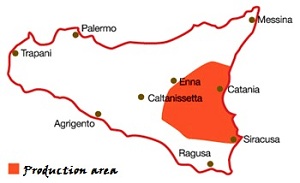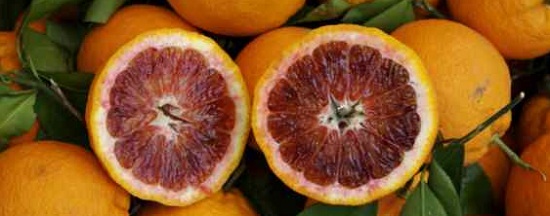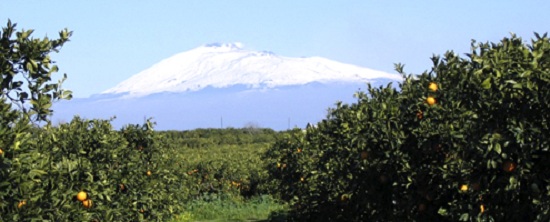
|
||||||||||||||||||||||||||||||||||||||||||||||||
|
||||||||||||||||||||||||||||||||||||||||||||||||
|
|
Red Oranges from Sicily
Researchers of the European project Athena have identified the genetic mechanism that regulates the healthy properties of the Sicilian red oranges.
Thanks go to the anthocyanins, (substances that have been recognized to be potent antioxidants, able to bring numerous benefits to the body) the Sicilian red oranges are placed at the top of the list of healthy fruits and healthy food. But what makes Sicilian red oranges so characteristic?
It is a gene. It's called "Ruby", and has been identified by researchers at the European Project Athena. The study, published in the journal Plant Cell, was conducted by the John Innes Centre in Norwich (UK) and the Centre for Research on Citrus and Crops Mediterranee from Acireale. Red oranges become such and develop their high content of anthocyanins, only in certain environmental conditions. They need for example, warm days and cool nights - the latter especially necessary during ripening.
The study also highlighted that the anthocyanins are present in both the red and other varieties, however, it clearly show their presence has a significant influence only to the red variety. How does this happen? Besides the already mentioned influence of the climate, the researchers found that this factor is determined by the characteristic of this gene Ruby present only in the red orange juice, capable of influencing the activity. "This part belongs to the class of sequences of DNA called retrotransposons - explains Eugenio Butelli, lead author of the study - What we have identified is inserted next to Ruby gene and controls its activity. In practice, this particular retrotransposon is responsible for the cascade that leads to the production of anthocyanins. "
"The retrotransposon we identified - continues Butelli - is also present in other oranges, but only in the red ones is inserted in place to act as a switch that activates the gene Ruby when the plant is exposed to temperatures rather cold." A combination of circumstances that makes the difference then. "In order to get real red oranges this specific retrotransposon and cold temperatures are both indispensable elements - specific Cathie Martin from the John Innes Centre and coordinator of Project Athena - I would like to emphasize the importance of a thorough understanding of the process involved in the production of anthocyanins in oranges. Several studies have shown that consumption of a blood orange juice reduces oxidative stress in diabetic patients, protects DNA from oxidative damage and may reduce the cardiovascular risk factors to the same extent as occurs with other foods rich in anthocyanins. It is clear that red oranges are an important resource for health and disease prevention. A better understanding of the genetic and molecular bases of the production of anthocyanins in these fruits can pave the way, through genetic engineering, to varieties of blood oranges that can be grown in warmer climates. This would make it possible to expand the cultivation and contribute to a greater availability of this particular type of citrus. "». "The study - says Giuseppe Reforgiato Recupero from the Research Centre for Citrus and Crops Mediterranee - underlines once again the unique environment in which red oranges develop their full potential beneficial. The cold factor alone is not a sufficient condition: the low temperatures induce the production of anthocyanins, but it is true that the warm and sunny days are needed to have a sweet and tasty fruit. This explains the difficulties encountered when trying to grow blood oranges in geographical locations other than those around Mount Etna. "A proof that Nature knows how to do his job. The research project Athena also has historical implication. Scientists have in fact examined the origins of blood oranges, using genetic techniques but also by referring to ancient books and paintings by Bartolomeo Bimbi, a Florentine artist, author of the Medici collection Citrus XVIII century. The results demonstrate that, while there is still a variety of red oranges in China, those of Sicily have originated as a result of a independent mutation, which probably occurred once the sweet orange was introduced in Mediterranean areas. Source : Athena Press Office.
Related pages : Red Oranges Consortium - Rosaria Red Oranges from Sicily
|

|
||||||||||||||||||||||||||||||||||||||||||||||
|
||||||||||||||||||||||||||||||||||||||||||||||||
 Revealed the secret of the "bloody" oranges from Sicily and their healing properties.
Revealed the secret of the "bloody" oranges from Sicily and their healing properties. 

 In the absence of these conditions, the fruits are not able to produce sufficient amounts of anthocyanins and end up looking like the very common varieties of oranges. And is therefore in Sicily, and more precisely in the typical climate of the area of Mount Etna that oranges find the perfect place for their proper development.
In the absence of these conditions, the fruits are not able to produce sufficient amounts of anthocyanins and end up looking like the very common varieties of oranges. And is therefore in Sicily, and more precisely in the typical climate of the area of Mount Etna that oranges find the perfect place for their proper development. 

